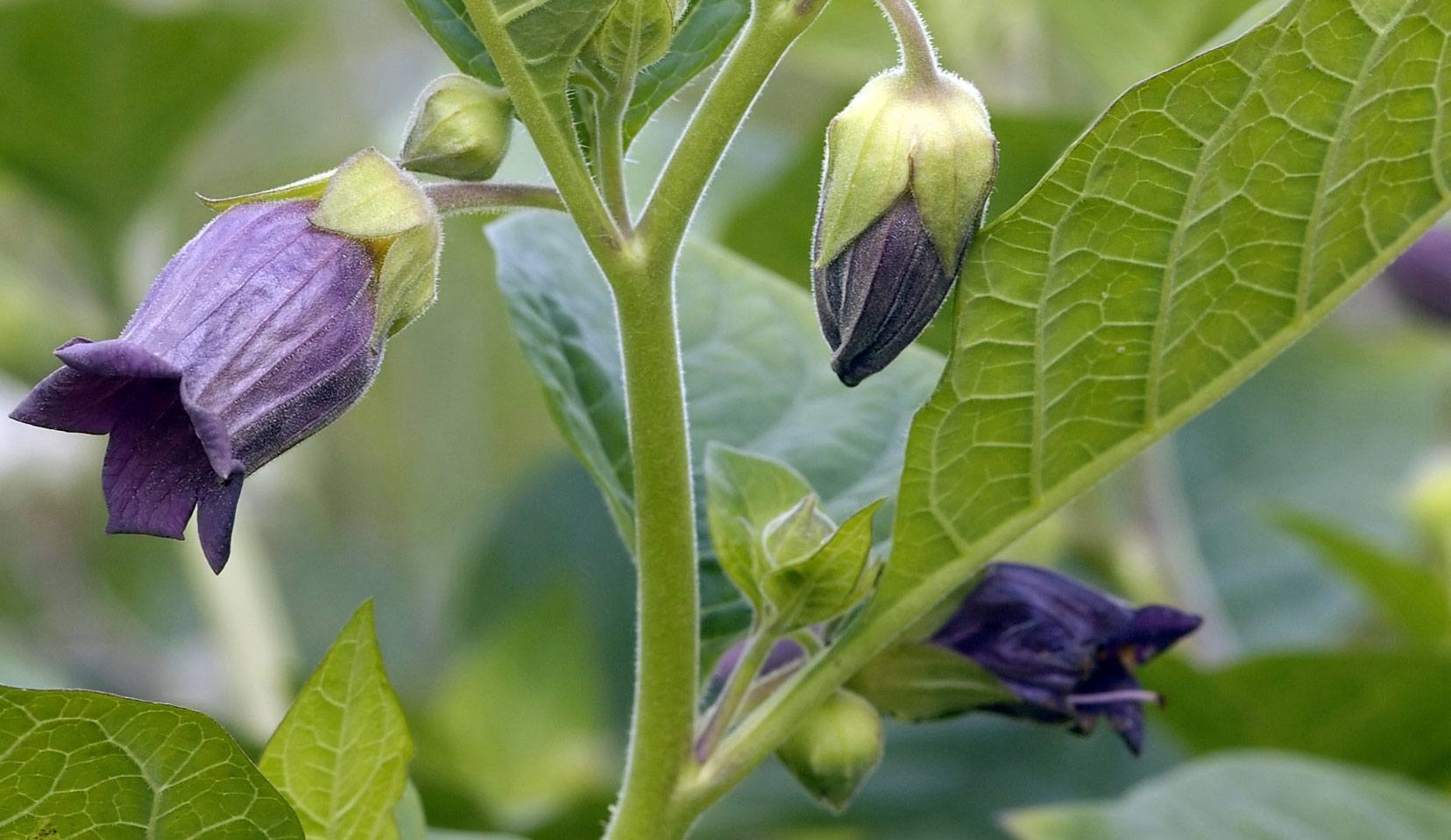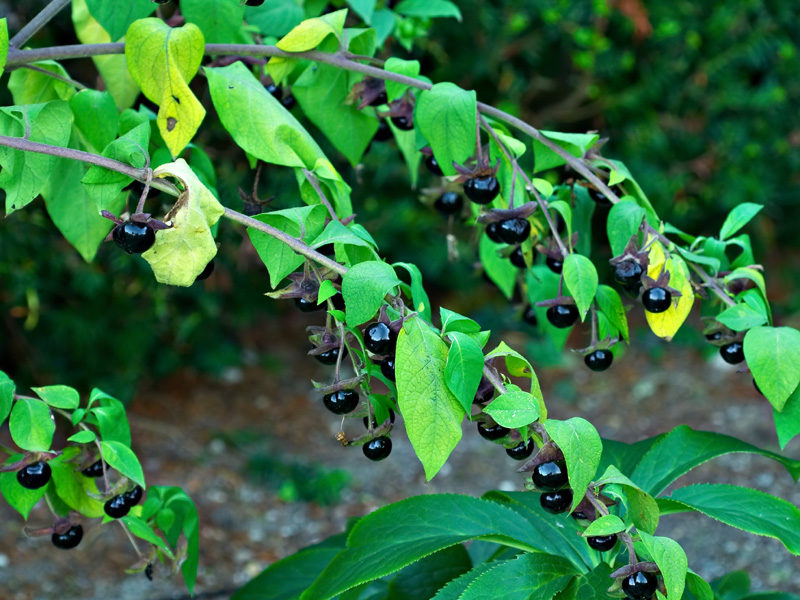They may look harmless enough, but plants can harbor some of the most deadly poisons known. From the death of Socrates by poison hemlock to the accidental ingestion of deadly nightshade by children, poisonous plants have been responsible for human deaths throughout history.
Like pretty well all living things, plants are equipped with natural defense mechanisms that help protect them from all the vicious animals out there that might want to eat them. In addition to stinging spikes and thorns, some plants are filled with deadly toxins that can make us violently ill or even kill us if we unwittingly ingest them. And, depending on where you live, some of these plants might even be growing in your own backyard, so it might be a good idea to learn a little bit more about them. Get to know some of the most infamous plants and their poisons with this macabre list.
Here are the 12 most terrifying (and deadly) plants in the world.
12. Jimsonweed (a.k.a. Devil’s Weed)
Jimsonweed grows throughout the United States, Canada, and some Caribbean Islands. In addition to being a powerful hallucinogen, the plant also contains many poisonous elements, mostly concentrated in its leaves and seeds.
Since the toxicity in jimsonweed varies depending on the plant’s age and the climate it resides in, careless usage — especially by directly sucking its juice or eating roots to achieve the hallucinogenic effect — often results in overdoses and death.

11. Atropa Belladonna (a.k.a. Deadly Nightshade)
Belladonna is among the most toxic plants found in the Eastern Hemisphere. Both the leaves and berries are extremely toxic and eating them can bring on a laundry list of symptoms that include dilated pupils, sensitivity to light, blurred vision, loss of balance, headaches, rashes, severely dry mouth, slurred speech, urinary retention, constipation, confusion, hallucinations, delirium, and convulsions.
The berries pose quite a risk to children because they look attractive and have a moderately sweet taste. Eating just five to ten berries would probably be enough to kill an adult; however, a single leaf is enough to prove fatal.

10. Aconite (a.k.a Wolfsbane)
Aconite, also known as wolfsbane, leopard’s bane, or devils helmet, is a perennial plant from the buttercup family that grows in the mountainous regions of the northern hemisphere. It contains very large quantities of a poison called alkaloid pseudaconitine, which at one point was used by the Ainu people of Japan to poison the tips of their hunting arrows. More recently, it was used by the Nazis in World War II to make their bullets more lethal.
In cases of ingestion, symptoms can include burning in the limbs and abdomen. However, if a large enough dose is taken (as little as 20 milliliters), death can occur in as little as two hours.
Wolfsbane is also referenced in mythology and pop culture as being able to either repel werewolves/lycanthropes, or, like in the Harry Potter books, to induce the wolf state regardless of the moon phase.

http://maintain-balance.tumblr.com/post/23505110788/aconite-aconitum-napellus-also-called-wolfsbane Source: maintain-balance.tumblr.com
9. Ageratina Altissima (a.k.a. White Snakeroot)
A deadly plant that commonly grows in North America is the white snakeroot. Though this plant is used as a remedy to treat snake bites, eating it can bring about a swift death. It contains a substance called tremetol that causes vomiting, thirst, and delirium before it kills you. It’s so poisonous that even drinking the milk or eating the meat of a cow that has ingested snakeroot can prove fatal. Milk sickness, as the disease came to be known, actually killed thousands of ignorant European settlers who came to North America and bred livestock in the early 19th century. Most notable among the deaths was Abraham Lincoln’s mother, Nancy Hanks.

https://en.wikipedia.org/wiki/Ageratina_altissima Source: wikipedia.org
8. English Yew
In nature, looks can be deceptive, so don’t be fooled by the tasty looking red berries on the English Yew tree. The small to medium sized tree is native to North Africa, Southwest Asia, and Europe, and grows juicy berries that contain some very poisonous seeds. The berries are actually the only part of this tree that are safe for birds to consume. For humans, ingesting just 50 grams would more than likely be a lethal dose.
Symptoms that indicate English Yew poisoning include difficulty breathing, muscle tremors, convulsion, collapse, and, in the end, cardiac arrest. In cases of severe poisoning, death can occur so quickly that the other symptoms go unnoticed.

http://www.bio.brandeis.edu/fieldbio/medicinal_plants/pages/English_Yew.htm Source: bio.brandeis.edu
7. Cerbera Odollam (a.k.a. The Suicide Tree)
Cerbera odollam, better known as the strychnine tree or ‘pong-pong’, to inhabitants of South East Asia, is a medium sized tree that grows green and orange mango-looking fruit. But despite their delicious appearance, the seeds within the fruit are highly toxic, containing the poisonous alkaloids strychnine and brucine. Just 30 milligrams of these potent toxins is enough to kill normal sized adult — usually in a very painful manner that involves violent convulsions brought on by simultaneous stimulation of sensory ganglia in the spine.
The plant was also ominously nicknamed ‘the suicide tree’ after it was found to be responsible for over 530 poisonings in the Kerala state of India. Sadly, many of those poison cases were suicides, most likely because cerbera odollam is widely available in that area and its lethality is well documented. In these cases the individuals remove the kernel from the fibrous seed husk and mash it with cane sugar to make a sweet, albeit deadly, final meal.

http://www.todayifoundout.com/index.php/2015/10/cerbera-odollam-aka-murder-tree/ Source: todayifoundout.com
6. Brugmansia (a.k.a. Angel’s Trumpets)
Brugmansia are flowering plants that can be found in a variety of tropical location throughout the world but are native to the tropical regions of South America. It gets the name angel’s trumpets from the dangling trumpet-shaped flowers that hang from the tree. Though the flowers look lovely and come in a variety of colors, including yellow, orange, pink, and white, all parts of the plant contain toxins like tropane alkaloids scopolamine and atropine. The plant has also been known to be used as a hallucinogenic drug that induces a powerful trance that is often accompanied by violent, sickening aftereffects that border on insanity.
There’s even a report recorded in Psychiatry and Clinical Neuroscience of a man who cut off his own tongue and penis after drinking a single cup of brugmansia tea. Scopolamine has been known to be used by scammers in some countries to take advantage of tourists by turning them into unwitting zombies that empty out their bank accounts and have no recollection of the events. It’s usually applied by blowing it in the victims face.
5. Oleander (a.k.a The Jericho Rose)
Described as a beautiful plant with pretty flowers that range from white to deep pink, oleander is native to parts of Asia but is now commonly grown as an ornamental hedge in many parts of the world including North America; an odd trend considering that everything on the oleander plant contains lethal cardiac glycosides that can cause violent illness just from coming into contact with it.
The Italian name for oleander translates as ‘ass killer’, which you think would be enough to dissuade anyone from eating them, but if you do happen to be unfortunate enough to ingest the poisonous seeds from the plant, expect to start feeling those ‘ass killing’ effects almost immediately. Symptoms usually involve a combination of cardiac and gastrointestinal problems including bloody diarrhea, vomiting, salivating profusely, and irregular heart beat. If treatment isn’t administered swiftly, the effects on the central nervous system are made evident by symptoms such as drowsiness, muscle tremors, seizures, collapse, comas, and eventually death. Indeed, the oleander toxins are so strong that there have been reports of people getting sick after eating honey made by bees that visited the flowers. Fortunately, deaths resulting from oleander poisoning are rare, as the plant has a very bitter taste that most people would find highly unpalatable.

http://www.guidewithme.com/apk/Middle_East/content/data/112099.html Source: guidewithme.com
4. Manchineel (a.k.a. Little Apple of Death)
Bearing the fruits known as ‘little apples of death’, the manchineel is one tree you’ll certainly want to avoid getting anywhere near. It can be found off the coasts of Florida, as well as South and Central America and has a reputation for being one of the world’s most poisonous trees.
In addition to the deadly fruit that grows on its branches, nearly every part of this tree is loaded with powerful toxins, especially the sap which contains phorbol — a strong skin irritant. Coming in contact with the sap provokes strong allergic dermatitis resulting in a painful blistering of the skin. This can present a perilous risk during rainy weather when people might think it’s a good idea to seek shelter under the tree’s leaves only to end up getting sprinkled with drops that have mixed with the sap. It only takes a minuscule amount of sap to make the skin break out in blisters, which perhaps isn’t so surprising given that it’s been known to strip the paint off of cars. Smoke from burning manchineel wood has also been known to cause permanent blindness.
The tree’s toxic bounty certainly didn’t go unnoticed by indigenous groups either. The Carib natives were said to use the sap to coat the tips of their arrow heads, pour the leaves into the wells of their enemies to poison their water supply, and even subject some unfortunate victims to slow and excruciating torture by tying them to the trunk of the tree.

https://en.wikipedia.org/wiki/Manchineel Source: Wikipedia
3. Water Hemlock (a.k.a. Poison Parsnip)
Closely related to the poison hemlock plant famously used to kill Socrates, water hemlock is largely considered to be North America’s most poisonous plant as it’s incredibly poisonous to humans. The plant is actually a wildflower in the carrot family and is sometimes confused with edible parsnips or celery, hence the nickname poison parsnip.
Water hemlock contains a toxin named cicutoxin, which is known for causing seizures if ingested. The toxin is found in all parts of the plant but is most highly concentrated in the roots, especially in the spring season. Other symptoms include nausea, vomiting, abdominal pains, tremors, and confusion. The ultimate cause of death is usually respiratory failure or ventricular fibrillation and can occur mere hours after ingestion.

http://www.summitpost.org/water-hemlock/304177 Source: summitpost.org
2. Castor Oil Plant
Castor plants are indigenous to India, Eastern Africa, and the Mediterranean basin. Lots of people are familiar with castor oil as a common remedy used to treat many skin conditions, but the flowering plant from which castor oil comes from is actually highly poisonous. Castor oil is made from the seeds of the plant but the seeds contain ricin — an extremely dangerous toxin that’s more potent than cyanide, strychnine, and many snake venoms. In fact, ricin is roughly 6000 times more poisonous than cyanide and one seed is enough to give you a slow and agonizing death over the course of 2 days as you experience horrible abdominal plain combined with bloody diarrhea and vomiting
Once symptoms start showing, the process is often irreversible with the final cause of death ultimately being dehydration. Surprisingly, humans are the most sensitive to the castor oil seeds, as it takes one to kill a full grown human, 11 to kill a dog, and massive dose of 80 to kill a duck.
Fun Fact: Ricin was Walter White’s go-to poisoning method on Breaking Bad; we can see why.

http://hbmag.com/castor-oil-pack-therapy-for-increased-immunity/ Source: hbmag.com
1. Abrus Precatorius (a.k.a. Rosary Pea)
Also known as crab’s eye, jumbie bead, and rosary pea, arbus precatorius is a wispy perennial climber that winds its way around shrubs, hedges, and trees. The plant is native to Indonesia, but grows in many other parts of the world as well.
The seeds are the most deadly part and, strangely enough, they’re often used as beads for jewelry because they have a pretty orangey red color with a single black spot. Though the seeds have a tough protective shell that can pass through the human digestive system intact, they contain the poison abrin, which is about 75 times stronger than ricin. Therefore, if the seed is scratched or chewed, it very well might be the deadliest plant on the planet as it’s able to kill an adult with as little as three micrograms (less than the amount contained within a single seed). Even when the seeds are used as bracelet or necklace beads they pose a huge threat, as jewelry makers have died after pricking their fingers on the drill bits used to make the tiny holes in the seeds.




